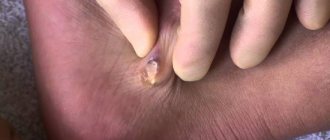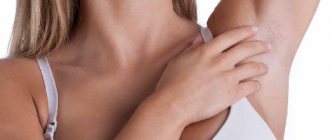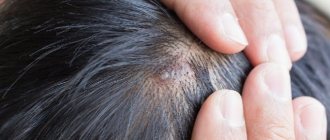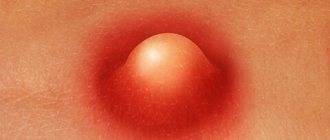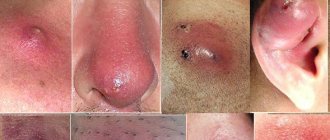A boil is a painful, benign formation of an infectious nature that can lead to the development of hazardous health consequences. The most common location of boils is the armpits due to the abundance of sweat glands and hair follicles. To treat a boil under the armpit correctly and effectively, you should study the characteristics of the disease in this area of the body.
Reasons: why an abscess appears in the armpit
A boil is a purulent lesion of the hair follicle, sebaceous gland and adjacent tissues.
The pathology looks like a cone-shaped lump with a necrotic core in the middle, filled with purulent contents.
An abscess in the armpit is the result of the harmful activity of Staphylococcus aureus (less commonly, white or streptococcus).
These bacteria are part of the microflora of human skin and usually do not cause any problems.
When do microorganisms become the culprits of skin pathology? Bacteria can trigger the development of a boil under the armpit as a result of:
- weakened immunity, when the body does not have enough protective antibodies to fight pathogens;
- increased sweating and excessive sebum secretion;
- metabolic disorders in the body, in particular diabetes;
- vitamin deficiency, which is caused by poor diet;
- overheating and hypothermia, leading to disruption of the regenerative processes of the skin;
- microtrauma of the skin due to careless hair removal under the armpit;
- poor hygiene in the armpit area, which leads to the accumulation of bacteria;
- the use of antiperspirants, the components of which interfere with the normal functioning of the sweat and sebaceous glands.
Symptoms
A furuncle under the armpit develops in several stages. At the level of infiltration, the affected area of the skin turns red, thickens and swells, reaching 1–3 cm in diameter. The patient complains of pain, tingling, and a feeling of heaviness in the arm.
The purulent-necrotic stage is characterized by an increase in infiltrate and the appearance of a rod in the center of the abscess. After 3-4 days, the boil in the armpit matures and bursts with the release of dead tissue and pus. From this moment the patient’s well-being improves, the symptoms of inflammation gradually disappear.
And at the last stage - healing - the wound from the boil heals, leaving behind a small scar.
Signs typical only for a boil will help you avoid confusing purulent abscesses under the armpit with hidradenitis:
- the inflamed formation has a conical shape;
- the infiltrate is quite disturbing, increased pain is noted during movement of the hand and careless pressure on the seal;
- there is noticeable redness and swelling around the boil;
- The ripening of the boil is accompanied by severe itching.
At the suppuration stage, the patient complains of fever, chills, general weakness, drowsiness, loss of appetite, and headache.
Boils under the armpit most often occur singly, but in rare cases, the simultaneous development of 3-4 foci can be observed. A similar process is called furunculosis.
Multiple inflammation can be acute, manifested by the appearance of several abscesses under the armpit at once, or chronic, occurring over a long period of time and severely. This form of the disease is registered in weakened patients with hypovitaminosis, metabolic disorders, and chronic ailments.
Symptoms of an abscess in the armpit
A boil that forms in the armpit makes itself felt with characteristic symptoms, which must be treated with due attention in order to begin treatment on time.
The development of a boil can often be stopped at the initial stage if you follow your doctor's recommendations.
What signs indicate that a purulent formation appears in the armpit:
- a compaction forms in the armpit, around which hyperemia is observed - redness of the skin;
- tingling, itching, burning sensation is felt at the site of the lesion, especially when rubbing against clothing;
- the patient feels throbbing pain, tightness of the skin, which becomes hot - this symptom is called hyperthermia, when the temperature in the affected area rises, usually by 2 - 3 degrees;
- freedom of movement is sharply limited, as it causes discomfort and pain;
- boils lead to inflammation of the lymph nodes, which become painful when touched. It also impairs shoulder and arm mobility;
- the swelling turns into a cone-shaped lump, in the center of which a necrotic rod appears with a black dot at the end.
The development of a boil in the armpit area is accompanied by symptoms of general intoxication - weakness, fatigue, high fever, headache, aching joints.
The symptoms of chiryak change as it develops. When it matures and the purulent contents begin to emerge, the swelling gradually decreases and the pain subsides.
Not all parents know whether it is possible to swim with chickenpox. Opinions for and against water procedures are discussed in this article.
Symptoms, treatment and photos of toxicoderma are presented in this publication.
You can find a photo of herpes on the fingers here: https://udermatologa.com/zabol/gerp/gerpes-na-rukah-foto-lechenie-na-paltsah-i-ladonyah/
Stages of development of neoplasms
Furunculosis, like other diseases, has several stages of development. These include the following stages of pathology:
- infiltration - the period of appearance of boils on human skin;
- necrotic - at this stage the tissues die, pus collects at the epicenter of the neoplasm;
- healing is the extreme stage of the disease, at which the abscess opens and the fluid comes out.
The formation of an abscess begins with a small red rash on the irritated area of the skin with a thickening in the very center. As a rule, a person is limited in movement and feels discomfort due to pain in this area of the body. The skin around the boil swells, hyperemia is observed, and the temperature rises.
The second stage of the disease begins on the fourth day after the rash appears. A pustule filled with pus forms in the center of the infected area, and a necrotic core forms underneath it. The pain syndrome increases, the person feels throbbing pain and cannot raise his arm painlessly. The patient's body heats up to 38 degrees. He is in a state of malaise, sweats intensely, feels nauseous, and his muscles hurt.
The extreme stage is the complete maturation of the abscess, its opening and the release of pus. The wound heals within a week and a half, leaving a depression in its place. The patient begins to feel much better.
Photo of a boil under the arm
What is the danger?
When self-treatment of boils does not produce results, or helps to treat boils but does not eliminate their causes, sooner or later this leads to a relapse. It should be remembered that treatment with folk remedies and ointments gives the body a reprieve to fight microbes, but if the immune system has not “learned” to treat furunculosis during this time, even more inflammation appears. Intense bacterial invasion provokes symptoms such as:
- constant inflammation;
- the appearance of red stripes from boils to lymph flows;
- temperature increase;
- general weakness and irritability.
Then be sure to take your feet to the doctor. Only a specialist can correctly determine the strain of the organism that provokes the boils and prescribe treatment with a course of antibiotics and then a probiotic so that your body can more easily endure the “chemical war.”
Source: zkozha.ru
Diagnostic methods
The main way to diagnose a boil in the armpit is a visual examination by a dermatologist. In some cases, additional examinations are required.
The fact is that boils need to be differentiated from other diseases:
- primarily from hidradenitis - purulent inflammation of the sweat gland. This pathology in the axillary region is more common than a boil;
- anthrax;
- trichophytosis granuloma.
To exclude these diseases and confirm the diagnosis of “furuncle”, the following appointment is required:
- general blood test;
- biochemical blood test (immunogram);
- dermatoscopy;
- bacterial culture - analysis of purulent exudate, based on the results of which the doctor will select appropriate antibiotics for treatment.
Pathogenesis
At its core, any furuncle under the arm is a limited inflammatory focus in which exudate accumulates. Gradually it begins to rise above the surface of the skin. Soreness and severe redness of the skin appear. Over time, spontaneous opening of the boil cavity occurs with the flow of internal secretion. It would seem that with this we can forget about the disease. But the fact is that the course of the boil under the arm is long-term with constant relapses.
Moreover, each time the number of inflammatory elements becomes more and more. More and more new areas of skin are captured. The lesions leave behind scars and age spots. Therefore, it is necessary to say a few words about what causes this disease.
With intense damage, a group of boils may appear, then we will talk about an inflammatory process called furunculosis. Formations appear only on the hairy surface of the skin.
It is sometimes not easy to distinguish boils from other types of disorders until the purulent stage of development, so at the first signs of a disease under the arm, it is worth seeking advice from a specialist. It is easier to cure the disease at the initial stage than to subsequently have a scar that forms during the independent rupture of the abscess.
Source: furunkul.com
How to treat a boil under the armpit
How exactly to treat a boil under the arm depends on what stage the disease is at.
At first, conservative methods can be quite effective, and a boil in an advanced state must be removed surgically.
Conservative therapy
To speed up the maturation of boils and prevent the inflammatory process, it is possible to prescribe physiotherapeutic procedures:
- electrophoresis;
- ultraviolet irradiation;
- laser therapy.
To treat the armpits at the infiltration stage, antiseptics are used:
- Furacilin solution;
- hydrogen peroxide;
- Chlorhexidine;
- medical alcohol.
For compresses, use Ichthyol ointment, Levomekol, Vishnevsky ointment, Baktroban, Fuzidin-Sodium, Dimexide.
While the boil is in the early stages of ripening, the doctor may prescribe antibiotic injections - they are used to prick the skin tissue around the boil.
To provide pain relief to the affected area, novocaine blockade is used. Fixing the arm with a special splint helps prevent pain.
The following medications are prescribed to relieve pain:
- Ketanov;
- Paracetamol;
- Ibuprofen.
Sometimes the use of antihistamines is required - Suprastin, Cetrin, Diazolin, Claritin. These medications eliminate skin irritation and itching.
Read our article with a list and description of pus-pulling ointments for boils at the following link.
Antibiotics
In order to cure a boil in the armpit, antibacterial agents are prescribed. They should never be used without the advice of a doctor.
Only a specialist can determine the need for their use and choose the drugs that are suitable for each patient.
The following antibiotics effectively treat ulcers in the armpit:
- Ampicillin;
- Erythromycin;
- Doxycillin;
- Cefazolin;
- Tetracycline;
- Levomycetin;
- Gentamicin.
Many of them are broad-spectrum drugs and effectively fight bacterial infections. They are used in the form of tablets, ointments, injections.
What are the dangers of taking antibiotics on your own? This can provoke resistance of pathogens to medications, which clearly complicates treatment.
Read more about in what cases, who and what antibiotics should be taken for furunculosis here.
Surgical intervention
An internal purulent abscess often has to be removed surgically. But the decision about the need for surgical intervention can only be made by a doctor.
This method is used if the inflammatory process has reached an advanced stage, as well as when complications arise.
Attempts to squeeze boils out on your own are fraught with dangerous consequences, so under no circumstances should you open abscesses at home.
The surgeon removes the boil using local anesthesia, so the operation is painless for the patient:
- The doctor opens the abscess and removes the purulent contents.
- Then the wound is treated with antiseptics and, if necessary, drainage is installed.
- A therapeutic bandage with a hypertonic (saline) solution or antibacterial ointment is applied. The dressings are changed periodically until the wound is completely healed.
The postoperative period includes the use of physical procedures, for example, UHF therapy, taking vitamin complexes, and immunomodulators.
It is important to exclude mechanical impact on the diseased area, so as not to injure the healing boil by friction during movement, clothing, and you should not use deodorants or a washcloth during bathing during this period.
You can read more about the boil removal operation here.
Treatment
Treatment should be carried out only under the strict guidance of a surgeon. Treatment at home can result in severe complications and hospitalization. Local and systemic agents are used.
Local remedies
In order for the boil to “ripe” quickly, it is necessary to apply ichthyol ointment twice a day, which can also be done at home. After applying it to the skin, you should cover the boil site with a thick layer of gauze, and then place a warm heating pad or a bag of heated salt on it.
Physiotherapeutic treatment will help speed up the process of “maturation” of the abscess. Ultraviolet irradiation should be used. You can also use Dimexide ointment, Shostakovsky balm, Levomekol during the infiltrative stage.
Expert opinion
Sakania Luiza Ruslanovna
Dermatovenerologist, cosmetologist, trichologist
Ask a Question
The hand under which the boil has arisen should be at rest so that friction does not occur. It is better to always have a bandage on the site of inflammation. When the purulent contents of the boil come out, its cavity should be washed with a solution of hydrogen peroxide.
This can also be done at home. Then you need to anoint the periphery with ichthyol ointment, brilliant green or iodine, and after opening the abscess, you need to put a small turunda soaked in hydrogen peroxide, furatsilin or other antiseptic into the wound itself.
Every 2 days you need to apply bandages with Vishnevsky ointment. In this case, the treatment will be much more effective.
Systemic drugs
After contacting a doctor with your problem, systemic medications are often prescribed to treat the inflammatory process. For this purpose, antibacterial agents (penicillins, macrolides), antihistamines (treatment of intoxication), and infusion therapy are used.
Surgical intervention
When treatment of a boil is carried out under the supervision of a doctor, the abscess is sometimes opened. This intervention can take place in a clinic if complications do not develop. After opening, the doctor washes the abscess cavity, installs drainage, which allows you to completely eliminate the necrotic masses.
If, after opening the boil and draining its cavity, a significant skin defect is formed, then sutures are used.
What should not be done with furunculosis?
- Do not squeeze out the boil. As the boil fills, its surface begins to thin out, and for a faster recovery, the patient can try to pierce it with a needle or other sharp object to release the pus. This cannot be done, because with a careless or deeper puncture, infected pus can penetrate into neighboring tissues or into the bloodstream, spreading throughout the body. It is also possible that the rod will partially remain inside, which will lead to a chronic process and frequent relapses of furunculosis. The boil should fill up and burst on its own. This usually happens within 1 - 2 weeks.
- Vishnevsky ointment should be used only after opening the abscess. Self-medication with this ointment at the beginning of the process is dangerous with the risk of the process spreading to phlegmon, therefore Vishnevsky ointment is used already at the granulation stage.
- Before contacting a doctor, do not treat the lesion with dyeing solutions - iodine, brilliant green, fucarcin. This blurs the clinical picture and it is difficult for the doctor to determine the true size of the compaction - infiltrate. That is, the risk of late diagnosis, neglect of the process, and the development of complications increases.
- When the boil has opened and dressings are being made, you cannot bathe or wet the wound. You should either completely eliminate or limit water procedures; it is better to wipe healthy skin with non-aggressive antiseptics, such as furacilin solution or salicylic alcohol.
What can a doctor do?
- While the boil is maturing - mandatory treatment with antiseptics, the doctor can inject the affected area with a solution of antibiotic and novocaine.
- Physiotherapy - the doctor may prescribe electrophoresis with antimicrobial agents to prevent complications - abscesses and cellulitis. UFO and UHF therapy are used at all stages of furunculosis.
- To increase the immune response, the doctor may prescribe gamma globulin, ozone therapy, autohemotransfusions and restorative drugs.
- When a fluctuation zone forms, the doctor applies an application with crystalline salicylic sodium to the center of the furunculosis elements, fixes it with a dry bandage, this promotes rapid rejection of the rod.
- After opening, both surgically and independently, the wound is washed with 3% hydrogen peroxide, then bandages are applied (changed every other day) with Levomikol, Vishnevsky ointment, Ichthyol, Syntomycin or Erythromycin ointment.
- In case of an abscess, the boil is opened under local anesthesia and the purulent-necrotic masses are removed.
- Taking antibiotics orally is prescribed only by a doctor. Their use is mandatory for multiple furunculosis, abscess, and chronic furunculosis. With a reduced immune status and weakened patients, antibiotics are prescribed intramuscularly.
Treatment with folk remedies at home
Folk remedies refer to auxiliary methods for treating boils in the armpit area.
They are good to use as an addition to basic drug therapy, but it is better to consult your doctor first.
Popular folk recipes include:
- Medicinal dough - prepare a mixture of dough-like consistency from the following ingredients: 1 yolk from a chicken egg, 30 g of butter, 1 teaspoon of honey and flour (you need enough of it to make the mass thick enough). The dough is applied to the boil, secured with a bandage and changed every 3 hours. The product draws out pus well, accelerates the maturation and opening of the boil.
- At the initial stage of infiltration, it is useful to apply leaves of medicinal plants to the sore spot. You can knead a leaf of golden mustache or place an aloe leaf on the boil, after peeling it off. Repeat the procedure several times a day.
- Healing ointment - mix 20 g of beeswax, 1 tablespoon of unrefined sunflower oil, 1 finely chopped onion. The mixture is simmered over low heat for about an hour and a half, then cooled. After thickening, the ointment is applied to the boil, covered with compress paper, and secured with a bandage. Change after 3 - 4 hours.
- Garlic compresses – chop a couple of medium cloves of garlic and mix with half a teaspoon of vegetable oil. Place the mixture on a cotton pad and secure it to the wound with an adhesive plaster. Keep for 4 – 5 hours. Garlic helps draw out the purulent mass from the boil, and the oil will protect the skin from burning. You can simply cut the garlic into thin slices and attach them to the surface of the abscess. Such procedures should be done every 3 hours. Garlic juice kills the infection and promotes the healing of the boil.
- Coniferous compresses - prepare a decoction from spruce, pine branches and coniferous tree cones. Let it brew and apply it as a lotion to the area of the boil. Cover the top with oilcloth and secure with a bandage. The compress will help relieve pain and speed up the healing process.
- Compress of cabbage and honey - lightly beat the leaf to soften it, grease it with a thin layer of natural bee product and apply it to the boil for several hours. Repeat the procedure until the abscess opens. The compress has an anti-inflammatory and anti-edematous effect.
- Grind a quarter of a bar of laundry soap (72%) using a grater, add a small amount of water and cook until the mass thickens. The cooled mixture is spread on gauze and secured to the sore spot. The bandage should be changed three times a day.
The greatest effect in the treatment of boils in the armpit is achieved with a reasonable combination of traditional and folk methods.
We wrote in detail about how to treat boils at home here.
Prevention of pathology
To prevent the formation of boils on the body or the recurrence of the disease, it is necessary to follow standard hygiene rules every day and protect the skin from mechanical damage.
Basic requirements for disease prevention:
- daily shower, change of underwear;
- prevention of skin injuries from cheap razors and hair removal devices;
- exclude clothes made from synthetic materials from your wardrobe;
- skin irritations should not be treated with iodine or brilliant green, only antiseptic ointments should be used;
- To improve immunity, sports activities, frequent walks in the fresh air, and maintaining good sleep are recommended;
- adding foods containing sufficient amounts of vitamins and minerals to the daily diet;
- Periodic visits to the doctor to prevent the disease at the initial stage.
Most often, axillary boils appear due to the fault of the patient himself due to non-compliance with standard hygiene rules. If pathology manifests itself repeatedly, you should definitely contact a dermatologist, surgeon, or immunologist. If you neglect the advice and help of these specialists, the disease can lead to serious complications.
What could be the consequences?
It is dangerous to ignore the treatment of a boil and hope that “maybe” it will go away on its own. An insidious disease is fraught with unpleasant consequences. Complications can also be caused by improper therapy and self-medication.
A boil under the armpit is dangerous due to its proximity to the lymph nodes; they can become inflamed as a result of the penetration of a purulent infection. This will result in the development of lymphadenitis.
What other consequences are possible with boils in the armpit area:
- lymphangitis - the disease consists of inflammation of the lymphatic vessels;
- furunculosis - the formation of multiple boils throughout the body;
- phlegmon is a purulent inflammation of the subcutaneous tissue that does not have clear boundaries;
- abscess - a local deep purulent focus of inflammation;
- sepsis – blood poisoning;
- damage to internal organs.
The risk of dangerous consequences increases significantly if the patient tries to squeeze out the boil on his own. In this case, the spread of infection is almost guaranteed.
The main causes, symptoms of herpes in the intimate area in women, as well as treatment and prevention measures are discussed in detail in this material.
Instructions for using Flucinar ointment are presented for review in our publication.
How dangerous is the disease?
If a person has a formation in the armpit, it is necessary to immediately begin treatment after visiting a dermatologist or surgeon . The disease not only causes pain in a person, but may also cause weakness, general malaise, and fever. And if the presence of one boil does not cause concern and is easily treatable, then several boils already indicate the presence of a serious infection in the body.
Multiple boils may appear. In this case, the patient is diagnosed with furunculosis. It is treated with medication. Surgery to remove the sweat glands is possible. They are the ones who provoke the development of the disease.
If you do not begin timely treatment of formations, serious complications and blood poisoning may occur . And this can lead to death.
What can't you do?
It is strictly forbidden to use the method of squeezing out an abscess.
If you try to pierce or squeeze out the boil, neighboring tissues may become infected and pus may enter the blood. Thanks to this fact, the infection can spread to the entire body. If part of the rod remains in the affected area, inflammation may become chronic. The ripening and breakthrough of boils must occur as an independent process. It is possible to use Vishnevsky ointment only after the abscess has broken through. Treatment at the beginning of the process can lead to the spread of the disease or to more severe consequences in the form of phlegmon.
Do not treat the inflamed area with coloring antiseptics in the form of iodine, brilliant green or furatsilin. Dyes can blur the picture of the clinical spread of the disease and make it difficult to establish the true size of the lesion. After opening the abscess, you should not bathe or wet the wound until dressings are no longer done.
Source: psoriazinform.ru
Antibiotics for boils in the ear
When boils form in the ear, antibiotic injections are usually indicated. Apply:
- penicillins;
- tetracyclines;
- macrolides in combination with sulfonamides.
Pimples in the ears should not be ignored
Antibiotics for a boil in the ear should be taken because the inner surface of the ear is located near the brain. Therefore, with their help, complications can be avoided.
If the disease is relapsing, penicillin is prescribed. The most effective are semi-synthetic medications, in particular Benemicin or Vibromycin.
When furunculosis becomes chronic, the doctor may decide to administer a staphylococcal vaccine, toxoid, antistaphylococcal immunoglobulin, or, in advanced cases, antilymphocyte immunoglobulin.
If physiotherapeutic procedures are carried out, then ointments and powders are suitable for topical use.



